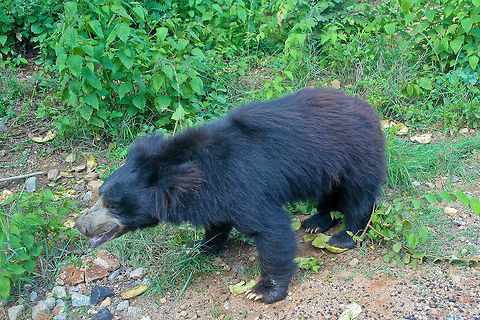
Appearance
Asian black bears are similar in general appearance to brown bears, but are more lightly built and more slender limbed. The skulls of Asian black bears are relatively small, but massive, particularly in the lower jaw. Adult males have skulls measuring 311.7–328 mm in length and 199.5–228 mm wide, while females have skulls measuring 291.6–315 mm long and 163–173 mm wide. Compared to other bears of the genus ''Ursus'', the projections of the skull are weakly developed; the sagittal crest is low and short, even in old specimens, and does not exceed more than 19–20% of the total length of the skull, unlike in brown bears, which have sagittal crests comprising up to 41% of the skull's length. Although mostly herbivorous, the jaw structure of Asian black bears is not as specialised for plant eating as that of pandas: Asian black bears have much narrower zygomatic arches, and the weight ratio of the two pterygoid muscles is also much smaller in Asian black bears. However, the lateral slips of the temporal muscles are thicker and stronger in black bears.In contrast to polar bears, Asian black bears have powerful upper bodies for climbing trees, and relatively weak hind legs, which are shorter than in brown bears and American black bears. A black bear with broken hind legs can still climb effectively. They are the most bipedal of all bears, and have been known to walk upright for over a quarter mile. The heel pads on the forefeet are larger than those of most other bear species. Their claws, which are primarily used for climbing and digging, are slightly longer on fore foot than back , and are larger and more hooked than those of the American black bear. The ears are bell shaped, and are proportionately longer than those of large bears, and stick out sideways from the head. The lips and nose are larger and more mobile than those of brown bears.
Adult black bears are slightly smaller than American black bears on average, though large males can exceed the size of several other bear species. They measure 70–100 cm in shoulder height, and 120–195 cm in body length. The tail is 11 cm long. Mature males typically weigh between 91–150 kg , with an average weight of about 113 kg . Females weigh about 65–90 kg , with large ones up to 140 kg . The famed British sportsman known as the "Old Shekarry" wrote of how a black bear he shot in India probably weighed no less than 363 kg based on how many people it took to lift its body, though Gary Brown, author of ''The Great Bear Almanac'' writes that the largest Asian black bear on record weighed 200 kg . Zoo-kept specimens can weigh up to at least 225 kg . Although their senses are more acute than those of brown bears, their eyesight is poor, and their powers of hearing moderate, the upper limit being 30 kHz.
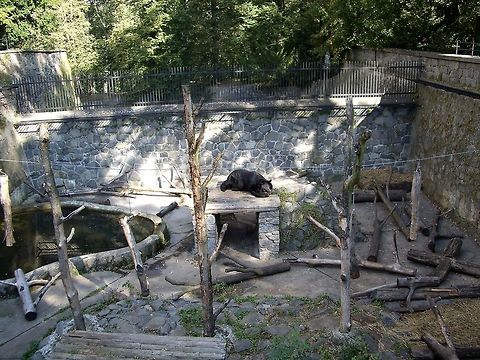
Naming
*Abor: ''Situm''⤷ Baluch: ''Mam''
⤷ Bengali: ''Balak'' or ''Bhalluk''
⤷ Bhotia: ''Thom''
⤷ Burmese: ''Wekwon''
⤷ Daphla: ''Sutum''
⤷ Garo: ''Mapol''
⤷ Hindi: ''Kala Bhalu'' or ''Reech'' Rikh in many areas of himachal pradesh
⤷ Japanese: ツキノワグマ , literally meaning "crescent bear"
⤷ Kachari: ''Miephúr'' or ''Musu-bhurma''
⤷ Kannada: ''Karadi''
⤷ Kashmiri: ''Seeah harpat''
⤷ Korean: 반달가슴곰 , literally "half-moon chest bear"
⤷ Kuki: ''Viempi''
⤷ Khowar: ''Shra Okhchz, ''
⤷ Mizo: ''Savawm'' or ''Vawmpui''
⤷ Lepcha: ''Sona''
⤷ Manchu: ''najihiyan'' , ''mojihiyan'', ''dojihiyan''
⤷ Manipuri: ''Sawom''
⤷ Naga: ''Húghúm'', ''Thagua'', ''Thega'', ''Chúp'', ''Sevam'' or ''Sápá''
⤷ Nepali: ''Sanár'' or ''Hingbong''
⤷ Persian: ''خرس''
⤷ Russian: Гимала́йский медве́дь or белогрудый медве́дь
⤷ Standard Chinese: 亞洲黑熊 亚洲黑熊 ''Yàzhōu hēixióng'', meaning "Asian black bear"
⤷ Tamil: ''Karadi''
⤷ Telugu: ''Elugu Banti''
⤷ Thai: หมีควาย , literally "buffalo bear"
⤷ Urdu: ریچھ Until the Late Pleistocene two further subspecies ranged across Europe and western Asia. These are ''Ursus thibetanus mediterraneus'' in western Europe and the Caucasus and ''Ursus thibetanus permjak'' from eastern Europe, especially the Ural Mountains.
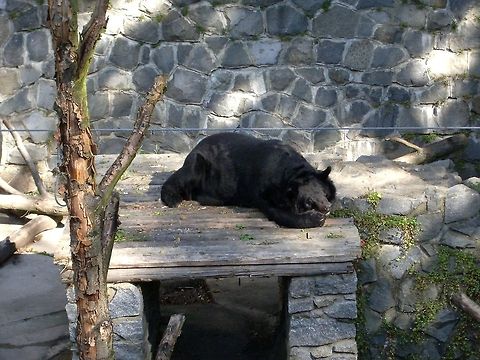
Distribution
Black bears typically inhabit deciduous forests, deserts, mixed forests and thornbrush forests. They rarely live in elevations of more than 12,000 feet . They usually inhabit elevations of 11,480 feet in the Himalayas in the summer, and will climb down to elevations of 4,920 feet in winter. They sometimes occur at sea level in Japan.The fossil record indicates that black bears once ranged as far west as Germany and France, though the species now occurs very patchily throughout its former range, which is now limited to the Asian continent. Black bears occupy a narrow band from southeastern Iran eastward through Afghanistan and Pakistan, across the foothills of the Himalayas in India, to Myanmar. With the exception of Malaysia, black bears occur in all countries in mainland Southeast Asia. They are absent from much of east-central China, though they have a patchy distribution in the southern and northeastern part of the country. Other population clusters exist in the southern Russian Far East and into North Korea. South Korea has a small remnant population. Black bears also occur in Japan's southern islands of Honshu and Shikoku and on Taiwan and Hainan.
There is no definitive estimate as to the number of Asiatic black bears: Japan posed estimates of 8–14,000 bears living on Honshū, though the reliability of this is now doubted. Although their reliability is unclear, rangewide estimates of 5–6,000 bears have been presented by Russian biologists. Rough density estimates without corroborating methodology or data have been made in India and Pakistan, resulting in the estimates of 7–9,000 in India and 1,000 in Pakistan. Unsubstantiated estimates from China give varying estimates between 15–46,000, with a government estimate of 28,000.
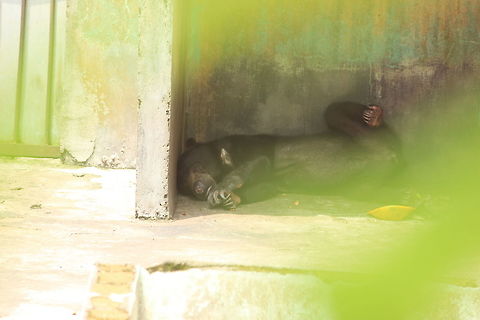
Status
The Asian black bear is listed as a protected animal in China's National Protection Wildlife Law, which stipulates that anyone hunting or catching bears without permits will be subject to severe punishment.Although the black bear is protected in India due to being listed as Vulnerable in the Red Data Book in Appendix I of CITES in India and in Schedule I of the Indian Wildlife Act and its 1991 amendment, it has been difficult to prosecute those accused of poaching black bears due to lack of witnesses and lack of Wildlife Forensic Labs to detect the originality of confiscated animal parts or products. Moreover, due to India's wide stretching boundaries with other nations such as Pakistan, Tibet, China, Nepal, Bhutan, Bangladesh and Myanmar, it is difficult to police such borders, which are often in mountainous terrain.
Five black bear populations, occurring in Kyushu, Shikoku, West-Chugoku, East-Chugoku and Kii areas, were listed as endangered by the Environmental Agency in the Japanese Red Data Book in 1991. Small isolated populations in the Tanzawa and Shimokita areas of mainland Honshū were listed as endangered in 1995. Beyond recognising these populations as endangered, there is still a lack of efficient conservation methods for Japanese black bears.
Black bears occur as an infrequent species in the Red Data Book of Russia, thus falling under special protection and hunting is prohibited. There is currently a strong movement to legalize the hunting of Russian black bears which is supported by most of the local scientific community.
As of January 30, 1989, Taiwan's Formosan black bears have been listed as an endangered species under the Natural and Cultural Heritage Act on, and was later listed as a Conserved Species Category I.
The Vietnamese Government issued Decision 276/QD, 276/1989 which prohibits the hunting and exporting black bears. The Red Book of Vietnam lists Vietnamese black bears as endangered.
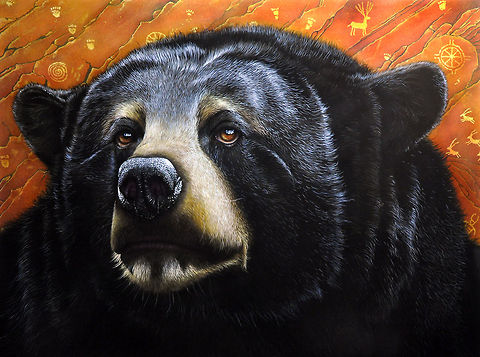
Behavior
Asian black bears are diurnal, though they become nocturnal near human habitations. They may live in family groups consisting of two adults and two successive litters of young. They will walk in a procession of largest to smallest. They are good climbers of rocks and trees, and will climb to feed, rest, sun, elude enemies and hibernate. Some older bears may become too heavy to climb. Half of their life is spent in trees and they are one of the largest arboreal mammals. In the Ussuri territory, black bears can spend up to 15% of their time in trees. Asian black bears break branches and twigs to place under themselves when feeding on trees, thus causing many trees in their home ranges to have nest-like structures on their tops. Asian black bears will rest for short periods in nests on trees standing fifteen feet or higher. Asian black bears do not hibernate over most of their range. They may hibernate in their colder, northern ranges, though some bears will simply move to lower elevations. Nearly all pregnant sows hibernate. Black bears prepare their dens for hibernation in mid October, and will sleep from November until March. Their dens can either be dug out hollow trees , caves or holes in the ground, hollow logs, or steep, mountainous and sunny slopes. They may also den in abandoned brown bear dens. Asiatic black bears tend to den at lower elevations and on less steeper slopes than brown bears. Female black bears emerge from dens later than do males, and female black bears with cubs emerge later than barren females. Asian black bears tend to be less mobile than brown bears. With sufficient food, Asian black bears can remain in an area of roughly 1–2 sq km, and sometimes even as little as 0.5–1 sq km.Asian black bears have a wide range of vocalisations, including grunts, whines, roars, slurping sounds and "an appalling row" when wounded, alarmed or angry. They emit loud hisses when issuing warnings or threats, and scream when fighting. When approaching other bears, they produce "tut tut" sounds, thought to be produced by bears snapping their tongue against the roof of their mouth. When courting, they emit clucking sounds.Within Sikhote-Alin, the breeding season of black bears occurs earlier than in brown bears, starting from mid June to mid August. Birth also occurs earlier, in mid January. By October, the uterine horns of pregnant females grow to 15–22 mm. By late December, the embryos weigh 75 grams. Sows generally have their first litter at the age of three years. Pregnant females generally make up 14% of populations. Similar to brown bears, Asian black bears have delayed implantation. Sows usually give birth in caves or hollow trees in winter or early spring after a gestation period of 200–240 days. Cubs weigh 13 ounces at birth, and will begin walking at four days of age, and open their eyes three days later. The skulls of newborn black bear cubs bear great resemblance to those of adult sun bears. Litters can consist of 1–4 cubs, with 2 being the average. Cubs have a slow growth rate, reaching only 2.5 kg by May. Black bear cubs will nurse for 104–130 weeks, and become independent at 24–36 months. There is usually a 2–3 year interval period before females produce subsequent litters. The average lifespan in the wild is 25 years, while the oldest Asian black bear in captivity died at the age of 44.
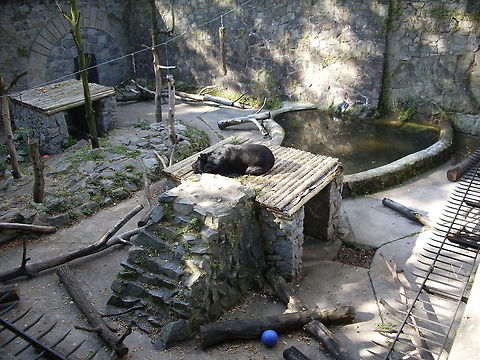
Habitat
Black bears typically inhabit deciduous forests, deserts, mixed forests and thornbrush forests. They rarely live in elevations of more than 12,000 feet . They usually inhabit elevations of 11,480 feet in the Himalayas in the summer, and will climb down to elevations of 4,920 feet in winter. They sometimes occur at sea level in Japan.The fossil record indicates that black bears once ranged as far west as Germany and France, though the species now occurs very patchily throughout its former range, which is now limited to the Asian continent. Black bears occupy a narrow band from southeastern Iran eastward through Afghanistan and Pakistan, across the foothills of the Himalayas in India, to Myanmar. With the exception of Malaysia, black bears occur in all countries in mainland Southeast Asia. They are absent from much of east-central China, though they have a patchy distribution in the southern and northeastern part of the country. Other population clusters exist in the southern Russian Far East and into North Korea. South Korea has a small remnant population. Black bears also occur in Japan's southern islands of Honshu and Shikoku and on Taiwan and Hainan.
There is no definitive estimate as to the number of Asiatic black bears: Japan posed estimates of 8–14,000 bears living on Honshū, though the reliability of this is now doubted. Although their reliability is unclear, rangewide estimates of 5–6,000 bears have been presented by Russian biologists. Rough density estimates without corroborating methodology or data have been made in India and Pakistan, resulting in the estimates of 7–9,000 in India and 1,000 in Pakistan. Unsubstantiated estimates from China give varying estimates between 15–46,000, with a government estimate of 28,000.
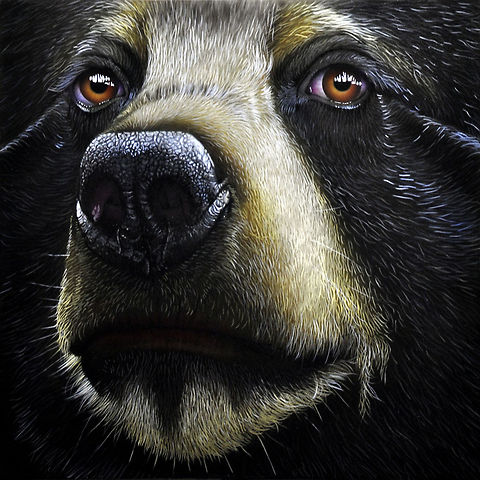
Reproduction
Within Sikhote-Alin, the breeding season of black bears occurs earlier than in brown bears, starting from mid June to mid August. Birth also occurs earlier, in mid January. By October, the uterine horns of pregnant females grow to 15–22 mm. By late December, the embryos weigh 75 grams. Sows generally have their first litter at the age of three years. Pregnant females generally make up 14% of populations. Similar to brown bears, Asian black bears have delayed implantation. Sows usually give birth in caves or hollow trees in winter or early spring after a gestation period of 200–240 days. Cubs weigh 13 ounces at birth, and will begin walking at four days of age, and open their eyes three days later. The skulls of newborn black bear cubs bear great resemblance to those of adult sun bears. Litters can consist of 1–4 cubs, with 2 being the average. Cubs have a slow growth rate, reaching only 2.5 kg by May. Black bear cubs will nurse for 104–130 weeks, and become independent at 24–36 months. There is usually a 2–3 year interval period before females produce subsequent litters. The average lifespan in the wild is 25 years, while the oldest Asian black bear in captivity died at the age of 44.Food
Asian black bears are omnivorous, and will feed on insects, beetle larvae, invertebrates, termites, grubs, carrion, bees, eggs, garbage, mushrooms, grasses, fruits, nuts, seeds, honey, herbs, acorns, cherries, dogwood, oak nuts and grain. Though herbivorous to a much greater degree than brown bears, and more carnivorous than American black bears, Asian black bears are not as specialised in their diet as pandas are: while pandas depend on a constant supply of low calorie, yet abundant foodstuffs, black bears are more opportunistic and have opted for a nutritional boom-or-bust economy. They thus gorge themselves on a variety of seasonal high calorie foods, storing the excess calories as fat, and then hibernate during times of scarcity. Black bears will eat pine nuts and acorns of the previous year in the April–May period. In times of scarcity, they enter river valleys to gain access to hazelnuts and insect larvae in rotting logs. From mid-May through late June, they will supplement their diet with green vegetation and fruit. Through July to September, they will climb trees to eat bird cherries, pine cones, vines and grapes. On rare occasions they will eat dead fish during the spawning season, though this constitutes a much lesser portion of their diet than in brown bears. In the 1970s, black bears were reported to kill and eat Hanuman langurs in Nepal. They are capable of killing ungulates such as muntjacs, serow, wild boar and adult water buffaloes, which they kill by breaking their necks.According to ''The great and small game of India, Burma, and Tibet'', regarding the hunting of black bears in British India:Black bear stalking in the forests bordering the valley of Kashmir requires much more care than is expended in approaching brown bear on the open hills above, the senses of sight and hearing being more strongly developed in the black than in the brown species. Many of these forests are very dense, so that it requires the eye of a practised shikari to detect the dark forms of the bears while searching for chestnuts on the ground without the advancing party being detected by the vigilant animals.
—''The great and small game of India, Burma, and Tibet'' p. 367
The book also describes a second method of black bear hunting involving the beating of small patches of forest, when the bears march out in single file. However, black bears were rarely hunted for sport, because of the poor quality of their fur and the ease by which they could be shot in trees, or stalked, as their hearing was poor.
Black bears here afford no sport; it is not shooting at all, it is merely potting a black thing in a tree... I can assure the reader that if he has a fondness for stalking, he will despise bear-killing, and will never shoot at them if there is a chance of anything else. If a man were to hunt for nothing else but bears, and kill a hundred in his six months' leave, he would not have enjoyed such real sport as he would, had he killed ten buck ibex or markhoor.
—''The rifle in Cashmere'' p. 73-74
Although easy to track and shoot, black bears were known by British sportsmen to be extremely dangerous when injured. Brigadier General R.G. Burton wrote of how many sportsmen had been killed by black bears after failing to make direct hits.
Today, black bears are only legally hunted for sport in Japan and Russia. In Russia, 75–100 black bears are legally harvested annually, though 500 a year are reportedly harvested illegally. Russian sport hunting of black bears became legalised in 2004. According to a 2008 article written in ''The Sun'', Russia's Slavic Hunting Club offers four day trips with four guaranteed black bear kills for the sum of £16,000. The article indicated that clients receiving permits for black bear hunts included people from Britain, the USA, Germany, Spain, Poland and Finland.
After the introduction of Buddhism in Japan, which prohibited the killing of animals, the Japanese compromised by devising different strategies in hunting bears. Some, such as the inhabitants of the Kiso area in the Nagano Prefecture, prohibited the practise altogether, while others developed rituals in order to placate the spirits of killed bears. In some Japanese hunting communities, black bears lacking the white chest mark are considered sacred. In the Akita Prefecture, bears lacking the mark were known by ''matagi'' huntsmen as ''minaguro'' or ''munaguro'' , and were also considered messengers of ''yama no kami''. If such a bear was shot, the huntsman would offer it to ''yama no kami'', and give up hunting from that time on. Similar beliefs were held in Nagano, where the completely black bears were termed ''nekoguma'' or cat-bear. ''Matagi'' communities believed that killing a bear in the mountains would result in a bad storm, which was linked to the belief that bear spirits could affect weather. The ''matagi'' would generally hunt bears in spring or from late autumn to early winter, before they hibernated. In mountain regions, bears were hunted by driving them upland to a waiting hunter who would shoot it. Bear hunting expeditions were preceded by rituals, and could last up to two weeks. After killing the bear, the ''matagi'' would pray for the bear's soul. Bear hunts in Japan are often termed ''kuma taiji'', meaning "bear conquest". The word ''taiji'' itself is often used in Japanese folklore to describe the slaying of monsters and demons.
Traditionally, the Atayal, Taroko, and Bunun tribes of Taiwan consider black bears to be almost human in their behaviours, and thus unjust killing of bears is equated with murder and will cause misfortunes such as disease, death, or crop failure. The Bunun people call black bears ''Aguman'' or ''Duman'' which means devil. Traditionally, a Bunun hunter who has accidentally trapped a bear has to build a cottage in the mountains and cremate the bear within it. The hunter must stay in the cottage alone, away from the village until the end of the millet harvest, as it is believed that the killing of a black bear will cause the millet crop to burn black. In the Tungpu area, black bears are considered animals of the "third category": animals with the most remote relationship to humans and whose activity is restricted outside human settlements. Therefore, when black bears encroach upon human settlements, they are considered ill omens. In this situation, the community can either destroy trespassing bears or settle somewhere else. The Rukai and Paiwan people are permitted to hunt black bears, though they believe that doing so will curse the hunters involved: Rukai people believe that hunting bears can result in disease. Children are forbidden from eating bear meat, which is itself not permitted to be taken within homes.
Predators
The main habitat threat to Chinese black bears is overcutting of forests, largely due to human populations increasing to over 430,000 in regions where bears are distributed, in the Shaanxi, Ganshu, and Sichuan provinces. 27 forestry enterprises were built in these areas between 1950 and 1985 . By the early 1990s, the black bear distribution area was reduced to only one-fifth of the area that existed before the 1940s. Isolated bear populations face environmental and genetic stress in these circumstances. However, one of the most important reasons for their decrease involves overhunting, as black bear paws, gall bladders and cubs have great economic value. Black bear harvests are maintained at a high level due to the harm they cause to crops, orchards and bee farms. During the 1950s and 1960s, 1000 bears were harvested annually in the Heilongjiang Province. However, purchased furs were reduced by 4/5, even by 9/10 yearly in the late 1970s to the early 1980s. Bears have also been declining annually in Dehong Dai and Jingpo Nations Autonomous Prefecture and the Yunnan Province.Poaching for gall bladders and skin are the main threat faced by black bears in India.
Although the poaching of bears is well known throughout Japan, authorities have done little to remedy the situation. The killing of nuisance bears is practiced year-round, and harvest numbers have been on the increase. Box traps have been widely used since 1970 to capture nuisance bears. It is estimated that the number of shot bears will decrease in time, due to the decline of old traditional hunters and the increase of a younger generation less inclined to hunt. Logging is also considered a threat.
Although black bears have been afforded protection in Russia since 1983, illegal poaching, fuelled by a growing demand for bear parts in the Asian market, is still a major threat to the Russian population. Many workers of Chinese and Korean origin, supposedly employed in the timber industry are actually involved in the illegal trade. Some Russian sailors reportedly purchase bear parts from local hunters to sell them to Japanese and Southeast Asian clients. Russia's rapidly growing timber industry has been a serious threat to the Asian black bear's home range for three decades. The cutting of trees containing cavities deprives black bears of their main source of dens, and forces them to den on the ground or in rocks, thus making them more vulnerable to tigers, brown bears and hunters.
In Taiwan, black bears are not actively pursued, though steel traps set out for wild boars have been responsible for unintentional bear trappings. Timber harvesting has largely stopped being a major threat to Taiwan's black bear population, though a new policy concerning the transfer of ownership of hill land from the government to private interests has the potential to affect some lowland habitat, particularly in the eastern part of the nation. The building of new cross island highways through bear habitat is also potentially threatening.
Vietnamese black bear populations have declined rapidly due to the pressures of human population growth and unstable settlement. Vietnamese forests have been: of the 87,000km2 of natural forests, about 1,000km2 disappear every year. Hunting pressures have also increased with a coinciding decline of environmental awareness.
South Korea remains one of two countries to allow bear bile farming to continue legally. As reported in 2009, approximately 1374 bears reside in an estimated 74 bear farms where they are kept for slaughter to fuel the demands of traditional Asian medicine. In sharp contrast, fewer than 20 bears can be found at Jirisan Restoration Center, located in Korea's Jirisan National Park.
Cultural
In Japanese culture, the black bear is traditionally associated with the mountain spirit and is characterised variously as "mountain man" , "mountain uncle" , "mountain father" , a loving mother and a child. Being a largely solitary creature, the bear is also viewed as "lonely person" . Black bears feature very little in lowland Japanese folklore, but are prominent in upland Japan, a fact thought to reflect the bear's greater economic value in upland areas. According to the local folklore in Kituarahara-gun in Niigata, the black bear received its white mark after being given a silk-wrapped amulet by ''yama no kami'', which left the mark after being removed.In Hindu mythology, the black bear Jambavantha is believed to have lived from Treta Yuga to Dvapara Yuga. In the epic ''Ramayana'', Jambavantha assists Rama in finding his wife Sita and battle her abductor, Ravana.
Asian black bears are briefly mentioned in Yann Martel's novel ''The Life of Pi'', in which they are described by the protagonist's father as being among the most dangerous animals in his zoo.
References:
Some text fragments are auto parsed from Wikipedia.